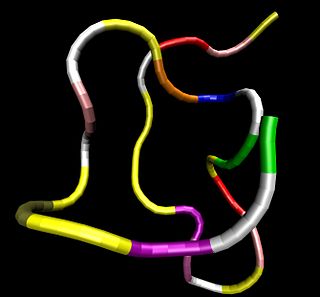
Atrial natriuretic peptide (ANP) or atrial natriuretic factor (ANF) is a natriuretic peptide hormone secreted from the cardiac atria that in humans is encoded by the NPPA gene. Natriuretic peptides are a family of hormone/paracrine factors that are structurally related. The main function of ANP is causing a reduction in expanded extracellular fluid (ECF) volume by increasing renal sodium excretion. ANP is synthesized and secreted by cardiac muscle cells in the walls of the atria in the heart. These cells contain volume receptors which respond to increased stretching of the atrial wall due to increased atrial blood volume.

Streptomyces is the largest genus of Actinomycetota and the type genus of the family Streptomycetaceae. Over 500 species of Streptomyces bacteria have been described. As with the other Actinomycetota, streptomycetes are gram-positive, and have genomes with high GC content. Found predominantly in soil and decaying vegetation, most streptomycetes produce spores, and are noted for their distinct "earthy" odor that results from production of a volatile metabolite, geosmin.
Nuclear magnetic resonance spectroscopy of proteins is a field of structural biology in which NMR spectroscopy is used to obtain information about the structure and dynamics of proteins, and also nucleic acids, and their complexes. The field was pioneered by Richard R. Ernst and Kurt Wüthrich at the ETH, and by Ad Bax, Marius Clore, Angela Gronenborn at the NIH, and Gerhard Wagner at Harvard University, among others. Structure determination by NMR spectroscopy usually consists of several phases, each using a separate set of highly specialized techniques. The sample is prepared, measurements are made, interpretive approaches are applied, and a structure is calculated and validated.

A natriuretic peptide is a hormone molecule that plays a crucial role in the regulation of the cardiovascular system. These hormones were first discovered in the 1980s and were found to have very strong diuretic, natriuretic, and vasodilatory effects. There are three main types of natriuretic peptides: atrial natriuretic peptide (ANP), brain natriuretic peptide (BNP), and C-type natriuretic peptide (CNP). Two minor hormones include Urodilatin (URO) which is processed in the kidney and encoded by the same gene as ANP, and Dendroaspis NP (DNP) that was discovered through isolation of the venom from the green mamba snake. Since they are activated during heart failure, they are important for the protection of the heart and its tissues.
Adolfo José de Bold was a Canadian cardiovascular researcher, best known for his discovery of atrial natriuretic peptide (ANP), a polypeptide hormone secreted by heart muscle cells. The hormone plays a role in regulating blood pressure, blood volume, and cardiovascular growth, and its discovery proved the endocrine function of the heart.

Bottromycin is a macrocyclic peptide with antibiotic activity. It was first discovered in 1957 as a natural product isolated from Streptomyces bottropensis. It has been shown to inhibit methicillin-resistant Staphylococcus aureus (MRSA) and vancomycin-resistant Enterococci (VRE) among other Gram-positive bacteria and mycoplasma. Bottromycin is structurally distinct from both vancomycin, a glycopeptide antibiotic, and methicillin, a beta-lactam antibiotic.
Naphthomycins are a group of closely related antimicrobial chemical compounds isolated from Streptomyces. They are considered a subclass of ansamycins.
Streptomyces cattleya is a Gram-positive bacterium which makes cephamycin, penicillin and thienamycin. The bacterium expresses a fluorinase enzyme, and the organism has been used to understand the biosynthesis of fluoroacetate and the antibacterial 4-fluoro-L-threonine. The γ-Glu-βes pathway to biosynthesis of non-traditional amino acids β-ethynylserine (βes) and L-propargylglycine (Pra) was first characterized in this species.
Ribosomally synthesized and post-translationally modified peptides (RiPPs), also known as ribosomal natural products, are a diverse class of natural products of ribosomal origin. Consisting of more than 20 sub-classes, RiPPs are produced by a variety of organisms, including prokaryotes, eukaryotes, and archaea, and they possess a wide range of biological functions.

The cyclothiazomycins are a group of natural products, classified as thiopeptides, which are produced by various Streptomyces species of bacteria.
Streptomyces anandii is a bacterium species from the genus Streptomyces which has been isolated from soil from in the region of Al-Taif in Saudi Arabia. Streptomyces anandii produces pentaene G8, gilvocarcin V, gilvocarcin M and gilvocarcin E.
Streptomyces cirratus is a bacterium species from the genus of Streptomyces. Streptomyces cirratus produces phegomycin, phegomycin D, phegomycin DGPT, cirratiomycin A, cirramycin A and cirramycin B.
Streptomyces diastatochromogenes is a bacterium species from the genus of Streptomyces. Streptomyces diastatochromogenes produces polyketomycin, concanamycin A, concanamycin B, concanamycin C, momofulvenone A, azdimycin, toyocamycin and oligomycins.
Streptomyces griseorubiginosus is a bacterium species from the genus of Streptomyces which has been isolated from soil in Russia. Streptomyces griseorubiginosus produces arylsulfatase, biphenomycin A, cinerubin A and cinerubin B.
Streptomyces laurentii is a bacterium species from the genus of Streptomyces which has been isolated from soil. Streptomyces laurentii produces thiostrepton.
Streptomyces nigrescens is a bacterium species from the genus of Streptomyces which has been isolated from soil. Streptomyces nigrescens produces 5-alkyl-1,2,3,4-tetrahydroquinolines and the antibiotics phoslactomycin A - F.

Brain natriuretic peptide 32 (BNP), also known as B-type natriuretic peptide, is a hormone secreted by cardiomyocytes in the heart ventricles in response to stretching caused by increased ventricular blood volume. Along with NT-proBNP, BNP is one of two natriuretic peptides.
Streptomyces lydicamycinicus is a bacterium species from the genus of Streptomyces. Streptomyces lydicamycinicus produces the antibiotic lydicamycin.
Lydicamycin is an organic compound with the molecular formula C47H74N4O10. Lydicamycin is an antibiotic with activity against Gram-positive bacteria. The bacteria Streptomyces lydicamycinicus and Streptomyces platensis produces lydicamycin.

Anaritide is a synthetic analogue of atrial natriuretic peptide (ANP).






